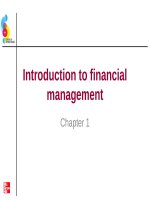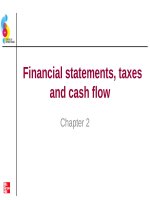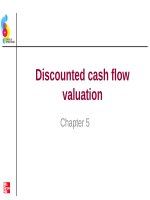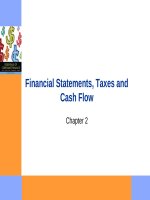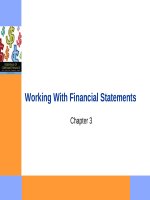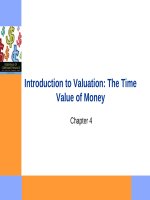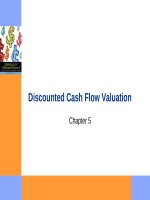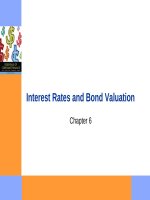Lecture essentials of corporate finance chapter 5 discounted cash flow valuation
Bạn đang xem bản rút gọn của tài liệu. Xem và tải ngay bản đầy đủ của tài liệu tại đây (469.74 KB, 59 trang )
Discounted Cash Flow Valuation
Chapter 5
Key Concepts and Skills
• Be able to compute the future value of multiple
•
•
•
•
•
cash flows
Be able to compute the present value of multiple
cash flows
Be able to compute loan payments
Be able to find the interest rate on a loan
Understand how loans are amortised or paid off
Understand how interest rates are quoted
Copyright 2007 McGraw-Hill Australia Pty Ltd
5-2
Chapter Outline
• Future and Present Values of Multiple Cash Flows
• Valuing Level Cash Flows: Annuities and
Perpetuities
• Comparing Rates: The Effect of Compounding
Periods
• Loan Types and Loan Amortisation
Copyright 2007 McGraw-Hill Australia Pty Ltd
5-3
Multiple Cash Flows – FV Example 5.1
• Find the value at year 3 of each cash flow
and add them together.
–
–
–
–
–
Today (year 0): FV = 7000(1.08)3 = $8,817.98
Year 1: FV = 4,000(1.08)2 = $4,665.60
Year 2: FV = 4,000(1.08) = $4,320
Year 3: value = $4,000
Total value in 3 years = 8817.98 + 4665.60 + 4320 +
4000 = $21,803.58
• Value at year 4 = 21,803.58(1.08) = $23,547.87
Copyright 2007 McGraw-Hill Australia Pty Ltd
5-4
Multiple Cash Flows – FV Example 2
• Suppose you invest $500 in a investment fund
today and $600 in one year. If the fund pays 9%
annually, how much will you have in two years?
–
FV = 500(1.09)2 + 600(1.09) = $1248.05
Copyright 2007 McGraw-Hill Australia Pty Ltd
5-5
Example 2 Continued
• How much will you have in 5 years if you make no
further deposits?
• First way:
–
FV = 500(1.09)5 + 600(1.09)4 = $1616.26
• Second way – use value at year 2:
–
FV = 1248.05(1.09)3 = $1616.26
Copyright 2007 McGraw-Hill Australia Pty Ltd
5-6
Multiple Cash Flows – FV Example 3
• Suppose you plan to deposit $100 into an account
in one year and $300 into the account in three
years. How much will be in the account in five
years if the interest rate is 8%?
–
FV = 100(1.08)4 + 300(1.08)2 = 136.05 + 349.92 = $485.97
Copyright 2007 McGraw-Hill Australia Pty Ltd
5-7
Example 3 Timeline
0
1
100
2
3
4
5
300
136.05
349.92
$485.97
Copyright 2007 McGraw-Hill Australia Pty Ltd
5-8
Multiple Cash Flows – Present Value
Example 5.3
• Find the PV of each cash flow and add them
–
–
–
–
–
Year 1 CF: 200 / (1.12)1 = 178.57
Year 2 CF: 400 / (1.12)2 = 318.88
Year 3 CF: 600 / (1.12)3 = 427.07
Year 4 CF: 800 / (1.12)4 = 508.41
Total PV = 178.57 + 318.88 + 427.07 + 508.41 = 1432.93
Copyright 2007 McGraw-Hill Australia Pty Ltd
5-9
Example 5.3 Timeline
0
1
200
2
3
4
400
600
800
178.57
318.88
427.07
508.41
$1432.93
Copyright 2007 McGraw-Hill Australia Pty Ltd
510
Multiple Cash Flows – PV Another
Example
• You are considering an investment that will pay
you $1000 in one year, $2000 in two years and
$3000 in three years. If you want to earn 10% on
your money, how much would you be willing to
pay?
–
–
–
–
PV = 1000 / (1.1)1 = $909.09
PV = 2000 / (1.1)2 = $1652.89
PV = 3000 / (1.1)3 = $2253.94
PV = 909.09 + 1652.89 + 2253.94 = $4815.93
Copyright 2007 McGraw-Hill Australia Pty Ltd
511
Example: Spreadsheet Strategies
• You can use the PV or FV functions in Excel to find
the present value or future value of a set of cash
flows
• Setting the data up is half the battle – if it is set up
properly, then you can just copy the formulas
• Click on the Excel icon for an example
Copyright 2007 McGraw-Hill Australia Pty Ltd
512
Decisions, Decisions
•
Your broker calls you and tells you that he has this great
investment opportunity. If you invest $100 today, you will
receive $40 in one year and $75 in two years. If you require a
15% return on investments of this risk, should you take the
investment?
– Use the CF keys to compute the value of the investment
–
CF; CF0 = 0; C01 = 40; F01 = 1; C02 = 75; F02 = 1
NPV; I = 15; CPT NPV = $91.49
No – the broker is charging more than you would be
willing to pay
Copyright 2007 McGraw-Hill Australia Pty Ltd
513
Saving for Retirement
• You are offered the opportunity to put some money
away for retirement. You will receive five annual
payments of $25,000 each beginning in 40 years.
How much would you be willing to invest today if
you desire an interest rate of 12%?
–
Use cash flow keys:
CF; CF0 = 0; C01 = 0; F01 = 39; C02 = 25000; F02 = 5; NPV;
I = 12; CPT NPV = $1084.71
Copyright 2007 McGraw-Hill Australia Pty Ltd
514
Saving for Retirement Timeline
0 1 2
…
39
40
41
42
43
44
0 0 0
…
0
25K 25K 25K 25K 25K
Notice that the year 0 cash flow = 0 (CF0 = 0)
The cash flows years 1 – 39 are 0 (C01 = 0; F01 = 39
The cash flows years 40 – 44 are 25,000 (C02 = 25,000;
F02 = 5)
5Copyright 2007 McGraw-Hill Australia Pty Ltd
15
Quick Quiz: Part 1
• Suppose you are looking at the following possible
cash flows: Year 1 CF = $100; Years 2 and 3 CFs
= $200; Years 4 and 5 CFs = $300. The required
discount rate is 7%
• What is the value of the cash flows at year 5?
• What is the value of the cash flows today?
• What is the value of the cash flows at year 3?
Copyright 2007 McGraw-Hill Australia Pty Ltd
516
Annuities and Perpetuities Defined
• Annuity – finite series of equal payments that occur
at regular intervals
–
–
If the first payment occurs at the end of the period, it is
called an ordinary annuity
If the first payment occurs at the beginning of the period,
it is called an annuity due
• Perpetuity – infinite series of equal payments
Copyright 2007 McGraw-Hill Australia Pty Ltd
517
Annuities and Perpetuities – Basic
Formulas
• Perpetuity: PV = C/r
• Annuities:
1
1
−
(1 +r ) t
PV =C
r
(1 +r ) t −
1
FV =C
r
Copyright 2007 McGraw-Hill Australia Pty Ltd
518
Annuities and the Calculator
• You can use the PMT key on the calculator for the
equal payment
• The sign convention still holds
• Ordinary annuity versus annuity due
–
–
–
You can switch your calculator between the two types by
using the 2nd BGN 2nd Set on the TI BA-II Plus
If you see “BGN” or “Begin” in the display of your
calculator, you have it set for an annuity due
Most problems are ordinary annuities
Copyright 2007 McGraw-Hill Australia Pty Ltd
519
Annuity – Example 5.5
• You borrow money TODAY so you need to
compute the present value.
–
48 N; 1 I/Y; -632 PMT; CPT PV = $23,999.54 ($24,000)
• Formula:
1
1 − (1.01) 48
PV = 632
.01
= $23,999.54
Copyright 2007 McGraw-Hill Australia Pty Ltd
520
Annuity – Sweepstakes Example
• Suppose you win the Publishers Clearinghouse
$10 million sweepstakes. The money is paid in
equal annual instalments of $333,333.33 over 30
years. If the appropriate discount rate is 5%, how
much is the sweepstakes actually worth today?
–
PV = 333,333.33[1 – 1/1.0530] / .05 = $5,124,150.29
Copyright 2007 McGraw-Hill Australia Pty Ltd
521
Buying a House
•
You are ready to buy a house and you have a $20,000
deposit and legal fees. Legal fees are estimated to be 4% of
the loan value. You have an annual salary of $36,000 and
the bank is willing to allow your monthly mortgage payment
to be equal to 28% of your monthly income. The interest rate
on the loan is 6% per year with monthly compounding (.5%
per month) for a 30-year fixed rate loan. How much money
will the bank loan you? How much can you offer for the
house?
Copyright 2007 McGraw-Hill Australia Pty Ltd
522
Buying a House – Continued
• Bank loan
–
–
–
Monthly income = 36,000 / 12 = $3,000
Maximum payment = .28(3,000) = $840
PV = 840[1 – 1/1.005360] / .005 = $140,105
• Total Price
–
–
–
Legal fees = .04(140,105) = $5,604
Deposit = 20,000 – 5604 = $14,396
Total Price = 140,105 + 14,396 = $154,501
Copyright 2007 McGraw-Hill Australia Pty Ltd
523
Example: Spreadsheet Strategies –
Annuity PV
• The present value and future value formulas in a
spreadsheet include a place for annuity payments
• Double-click on the Excel icon to see an example
Copyright 2007 McGraw-Hill Australia Pty Ltd
524
Quick Quiz: Part 2
• You know the payment amount for a loan and you
want to know how much was borrowed. Do you
compute a present value or a future value?
• You want to receive $5000 per month in retirement.
If you can earn .75% per month and you expect to
need the income for 25 years, how much do you
need to have in your account at retirement?
Copyright 2007 McGraw-Hill Australia Pty Ltd
525

